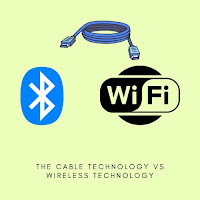The Truth About the Cable Technology vs
Wireless Technology
Cable technology is more than a means of connecting
devices. It is a method of keeping your devices connected as well as sending
and receiving data. In addition, cable technology is more dependable than
wireless technology. Wireless technology can be unreliable as well as slow.
Cable technology is also more user-friendly. You can easily connect your
devices to the cable network, as well as transfer data between them.
Twisted – Pair Cable
Twisted-pair cable is a type of cabling used for telephone
communications as well as the most recent Ethernet networks. Twisted pair
cables are made up of two insulated wires that have been twisted together.
There are two types of twisted-pair cables.
- Unshielded twisted
pair (UTP)
- Shielded twisted
pair (STP).
Unshielded twisted pair (UTP)
The term 'unshielded' indicates that it does not believe
physical shielding can prevent interference. These are used for both
residential and commercial internet access. A Registered Jack 45 (RJ-45)
connector is used to connect the UTP cable. There are various UTP categories.
(CAT1 = 1Mbps, CAT2 = 4Mbps, and CAT5e = 1Gbps).
Shielded twisted pair (STP).
Each pair of STP wires is wrapped in metallic foil, and STP
cables can use the same RJ connectors as UTP cables. In Ethernet networks, STP
is rarely used.
Coaxial Cables
Coaxial cables are high-frequency transmission cables made
of a single solid-copper core that electrically transfers data over the inner
conductor. Coaxial cables have an 80X transmission capacity compared to twisted
pair cables. This type of cable is typically used to transmit TV signals and to
connect computers to a network or the internet. Coaxial has anti-jamming
properties and may effectively protect signals from interference. The cost is
higher than for twisted-pair cables. There are also two kinds of coaxial
cables.
Fiber Optic Cables
Fiber optic cabling is the most recent type of transmission
cabling technology. Rather than transferring data over copper wires, these
cables contain optical fibers that send data via light pulses rather than
electrical pulses. Each optical fiber is plastic-coated and enclosed in a
protective tube. As a result, fiber optic cables are extremely resistant to
external interference. The end result is a highly reliable, high-speed
reference with 26,000X the transmission capacity of twisted-pair cables - but
at a much higher cost. There are two types of fiber cables.
|
Basis |
Twisted
pair |
Coaxial |
Fiber
optic |
|
Types |
Unshielded
Twisted Pair, and Shielded Twisted Pair |
50Ω 75Ω |
Single
mode fiber, and Multimode fiber |
|
Made
|
Pair
of copper wire. |
A solid
conductor wire, a grounding conductor and a layer of exterior
insulation. |
Fibers
can be made of glass or plastic. |
|
Speed |
Relatively
low speed in comparison to fiber optical cable |
Relatively
low speed in comparison to fiber optical cable |
Relatively
faster speed in comparison to twisted pair and coaxial cable. |
|
Bandwidth |
Low |
High |
Very
high |
|
Security
of transmitted signal |
Not
guaranteed |
Not
guaranteed |
Guaranteed |
|
Price |
Lowest |
Higher
than twisted pair, lower than fiber optics |
highest |
Wi-Fi wireless
technology
Wi-Fi is a wireless local area network technology that
allows devices to exchange data or connect to the internet by using 2.4 GHz UHF
and 5 GHz SHF radio waves. Wi-Fi is defined by the Wi-Fi Alliance as
"wireless local area network (WLAN) products that support the Institute of
Electrical and Electronics Engineers (IEEE) 802.11 standards. "Wi-Fi is
supported by a wide range of devices, including personal computers,
smartphones, tablet computers, and digital audio players. These can connect to
a network resource, such as the internet, through a wireless network access
point, and have a range of about 20 meters indoors and a greater range
outdoors. IEEE 802.11ac, which supports download speeds of up to 1Gbps and
7Gbps.
Bluetooth wireless technology standard
Bluetooth is not a network standard for full-scale wireless
Ethernet networking. Instead, Bluetooth was created as a specialized wireless
technology for short distances. Bluetooth will be used with cell phones, laptop
computers, printers, and other external devices. The maximum distance for a
Bluetooth network is approximately 30 feet. Bluetooth requires very little
power to operate. It is slower than the 802.11b network standard. Bluetooth
uses the 2.4 GHz broadcasting spectrum, which interferes with existing 802.11b
and 802.11g networks.



.jpg)


No comments:
New comments are not allowed.